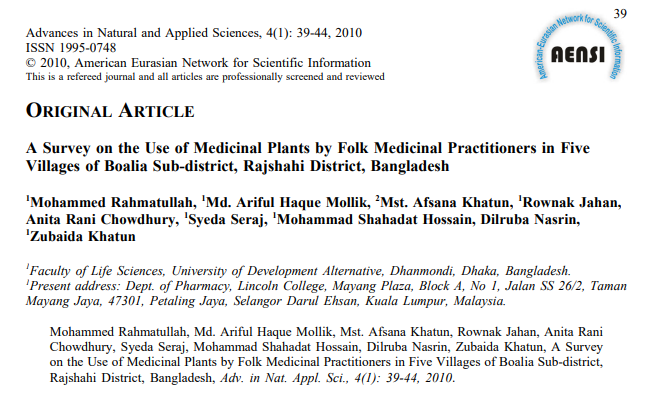A Survey on the Use of Medicinal Plants by Folk Medicinal Practitioners in Five Villages of Boalia Sub-district, Rajshahi District, Bangladesh
An ethnomedicinal survey was carried out in the villages of Muktarpur, Shyampur, Belgharia, Naodar, and Yusufpur situated in Boalia sub-district, Rajshahi district, Bangladesh. The objective of this survey was to find out about medicinal plants used by the folk medicinal practitioners (Kavirajes) of the five villages to treat various ailments. Informed consent was obtained from the Kavirajes prior to the survey. Interviews were conducted with the help of a semi-structured questionnaire and the guided field-walk method, where the Kavirajes took the interviewers to places from where they collected their medicinal plants, pointed out the plants, and described their uses. It was observed that the Kavirajes used a total of 48 plants distributed into 30 families. The Fabaceae family contributed 5 plants, followed by the Euphorbiaceae and Meliaceae families with 4 plants each, and the Combretaceae and Lamiaceae families with 3 plants each. Of the 48 medicinal plants used, 13 plants were cultivated for homestead use or commercial purposes. Leaves constituted the major plant part used (27.6%), followed by fruits (15.3%), and seeds (14.3%). Other plant parts administered for treatment included whole plant, roots, stems, barks, flowers, and tubers. Gastrointestinal disorders made up the major ailment treated by the Kavirajes, followed by skin disorders and respiratory tract disorders. The Kavirajes also treated ailments like reproductive disorders, hepatic disorders, cardiovascular disorders and hypertension, sexually transmitted diseases, cancer, helminthiasis, edema, diabetes, rheumatoid arthritis, epilepsy, cholera, tuberculosis, malaria, urinary tract disorders, nerve disorders, typhoid, eye disorders, leprosy, pain, hernia, goiter, anemia, cuts and wounds, and piles. Several of the above disorders are difficult to cure or incurable with modern allopathic medicines. These ailments include cancer, diabetes, rheumatoid arthritis, and epilepsy. That the Kavirajes have been treating these ailments for years points to considerable patient satisfaction in obtaining a cure. Thus the plants used by the Kavirajes present considerable potential for further scientific analysis and the discovery of better medicines.
Full text article available at:
http://scinet.dost.gov.ph/union/Downloads/39-44_181930.pdf


